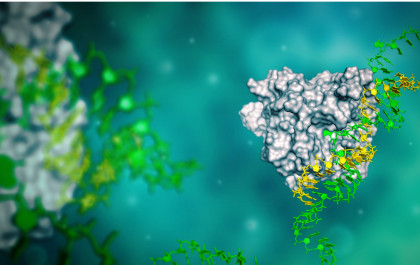ProQR Announces Publication in Nature Medicine for Sepofarsen in Leber Congenital Amaurosis 10
LEIDEN, Netherlands & CAMBRIDGE, Mass., April 13, 2021 (GLOBE NEWSWIRE) -- ProQR Therapeutics N.V. (Nasdaq:PRQR), a company dedicated to changing lives through the creation of transformative RNA therapies for severe genetic rare diseases, today announced the publication in the scientific journal Nature Medicine titled “Durable vision improvement after a single treatment with antisense oligonucleotide sepofarsen: a case report” describing durable vision improvement after treatment with sepofarsen in a clinical trial for CEP290 mediated Leber congenital amaurosis 10 (LCA10).
“We are excited to share these findings with the scientific and medical community,” said lead author Professor Artur V. Cideciyan, Ph.D., one of the co-investigators at the Scheie Eye Institute of the University of Pennsylvania. “Treatment with sepofarsen resulted in substantial, concordant and enduring improvement in more than a dozen different subjective and objective measurements of visual function as well as retinal structure.”
“We are highly encouraged by the data showing sepofarsen had such a beneficial effect on this child’s vision,” said Aniz Girach, MD, Chief Medical Officer of ProQR, “The visual field improvements observed indicate that RNA therapy could potentially be used to treat early stage disease, which is enabled by the broad distribution of intravitreal RNA therapy throughout the retina.”
Published results highlight a patient who is homozygous for the c.2991+1655A>G mutation in CEP290 and was part of a larger cohort in the Phase 1/2 clinical trial. The patient was studied for 15 months after intravitreal treatment with sepofarsen. Concordant measures of visual function and retinal structure including visual acuity, light sensitivity and visual fields, reached a substantial efficacy peak near three months after injection and remained better than baseline at 15 months.
About Leber Congenital Amaurosis 10 (LCA10)
Leber congenital amaurosis (LCA) is the most common cause of blindness due to genetic disease in children. It consists of a group of diseases of which LCA10 is the most frequent and one of the most severe forms. LCA10 is caused by mutations in the CEP290 gene, of which the c.2991+1655A>G mutation has the highest prevalence. LCA10 leads to early loss of vision causing most people to lose their sight in the first few years of life. To date, there are no treatments approved that treat the underlying cause of the disease. Approximately 2,000 people in the Western world have LCA10 because of this mutation.
About Sepofarsen
Sepofarsen (QR-110) is being evaluated in the pivotal Phase 2/3 Illuminate trial and is a first-in-class investigational RNA therapy designed to address the underlying cause of Leber congenital amaurosis 10 due to the c.2991+1655A>G mutation (also known as the p.Cys998X mutation) in the CEP290 gene. The c.2991+1655A>G mutation leads to aberrant splicing of the mRNA and non-functional CEP290 protein. Sepofarsen is designed to enable normal splicing, resulting in restoration of normal (wild type) CEP290 mRNA and subsequent production of functional CEP290 protein. Sepofarsen is intended to be administered through intravitreal injections in the eye and has been granted orphan drug designation in the United States and the European Union and received fast-track designation and rare pediatric disease designation from the FDA as well as access to the PRIME scheme by the EMA.
About ProQR
ProQR Therapeutics is dedicated to changing lives through the creation of transformative RNA therapies for the treatment of severe genetic rare diseases such as Leber congenital amaurosis 10, Usher syndrome and retinitis pigmentosa. Based on our unique proprietary RNA repair platform technologies we are growing our pipeline with patients and loved ones in mind.
Learn more about ProQR at www.proqr.com.
Forward Looking Statements
This press release contains forward-looking statements. All statements other than statements of historical fact are forward-looking statements, which are often indicated by terms such as "anticipate," "believe," "could," "estimate," "expect," "goal," "intend," "look forward to", "may," "plan," "potential," "predict," "project," "should," "will," "would" and similar expressions. Such forward-looking statements include, but are not limited to, statements regarding sepofarsen, and the clinical development and the therapeutic potential thereof. Forward-looking statements are based on management's beliefs and assumptions and on information available to management only as of the date of this press release. Our actual results could differ materially from those anticipated in these forward-looking statements for many reasons, including, without limitation, the risks, uncertainties and other factors in our filings made with the Securities and Exchange Commission, including certain sections of our annual report filed on Form 20-F. Given these risks, uncertainties and other factors, you should not place undue reliance on these forward-looking statements, and we assume no obligation to update these forward-looking statements, even if new information becomes available in the future, except as required by law.
ProQR Therapeutics N.V.
Investor Contact:
Sarah Kiely
ProQR Therapeutics N.V.
T: +1 617 599 6228
skiely@proqr.com
or
Hans Vitzthum
LifeSci Advisors
T: +1 617 430 7578
hans@lifesciadvisors.com
Media Contact:
Cherilyn Cecchini, MD
LifeSci Communications
T: +1 646 876 5196
ccecchini@lifescicomms.com


